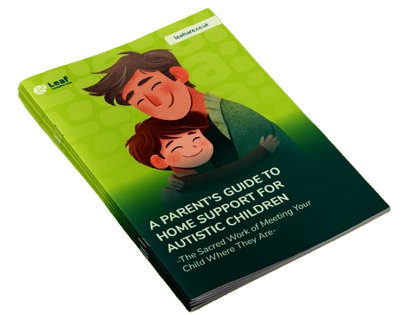Key Takeaways
- Learning difficulties are neurological differences that affect how the brain processes information. They can impact various areas of learning, such as reading, writing, mathematics, and comprehension.
- Learning difficulties, often identified during the school-age years, can include ADHD, Dyslexia, Dyspraxia, Dyscalculia, and Dysgraphia. These learning difficulties affect the person’s ability to acquire certain types of skills and can co-occur with other learning difficulties.
- Signs of learning difficulties can manifest early in school-age children and later in life can affect performance in higher education and work. If not properly identified and addressed, these difficulties can lead to low confidence and mental health challenges.
- Support for people living with learning difficulties includes speech and language therapy, occupational therapy, educational therapy, group/play therapy, and sensory learning programs.
- Leaf Complex Care’s in-house therapy team provides tailored care that meets the needs of people living with a learning difficulty or disability, focusing on enhancing their strengths and quality of life.
What is a Learning Difficulty?
Learning difficulties are neurological differences that can affect the brain’s ability to absorb, analyse, store, and process information. A learning difficulty refers to significant challenges or obstacles that an individual may experience when acquiring new skills or knowledge. These difficulties can impact various areas of learning, such as reading, writing, mathematics, and comprehension.
When it comes to written words, people living with learning difficulties may face challenges with recognising letters, understanding the relationship between letters and sounds, and comprehending written text. Reading and writing difficulties can manifest in different ways, such as difficulty decoding words, slow reading speed, poor spelling, and challenges understanding and expressing ideas in writing.
Speech and language therapists often work with people with learning difficulties related to written language. They can assess the person’s language skills, including phonological awareness, vocabulary, and syntax, and provide targeted interventions to improve reading and writing abilities. These interventions may include structured literacy instruction, phonological awareness training, and strategies to enhance reading comprehension and written expression.
Leaf Complex Care’s speech and language therapists are highly trained to assess speech, language, cognitive-communication, and oral/feeding/swallowing skills, enabling them to identify challenges and determine the proper treatment methods. Some strategies employed include language intervention activities, such as interacting with the individual through play, talking, and using pictures, books, or objects to stimulate language development.
⇒ Read more about the Specialised Support From Our Expert Therapy Team.
Learning Difficulties and Neurodiversity
The concept of neurodiversity emphasises recognising neurological differences as a valued aspect of human variation. It promotes the idea that there is no single right way of thinking, learning, or behaving and that differences are not viewed as something negative. This approach challenges negative social connotations and aims to facilitate the contribution of people with diverse neurotypes to the world as they are rather than conforming to a more ‘typical’ standard.
The term neurodiversity is used as an umbrella term for a variety of differences, including dyslexia, dyspraxia, ADHD, Tourette’s, and autism. This perspective challenges the traditional emphasis on difficulties and needs associated with special educational needs, learning disabilities, and specific learning difficulties, reframing them as neurodiverse and highlighting the positive aspects of thinking differently.
Types of Learning Difficulties
Learning difficulties are often identified during the school-age years (early childhood). Specific learning difficulties might not be discovered until the person attends college or starts working. Learning difficulty is an umbrella term for neurodevelopmental conditions that affect the person’s ability to acquire several types of skills.
Below are the most common learning difficulties under the neurodivergent umbrella and the strengths associated with them.
ADHD
Attention Deficit Hyperactivity Disorder (ADHD) is a neurological difference that affects people in diverse ways. It’s essential to understand that ADHD is a natural variation in how the brain functions. People with ADHD may experience challenges with attention, impulse control, and hyperactivity. Still, they also can bring unique strengths, such as incredible creativity and experiencing out-of-the-box thinking. When we approach ADHD from a perspective of neurodiversity, we recognise that each person’s experience with ADHD is different and should be supported in a way that honours their individuality and strengths.
It is common for a child living with ADHD to experience another learning difficulty, such as auditory processing disorder (APD). Studies show that 33% of children with ADHD have at least one co-occurring condition.
⇒ Read more about ADHD as a learning difficulty and how it impacts people’s lives.
Dyslexia
Dyslexia is a learning difficulty that impacts the way people process language and information. It can also impact other areas, such as organisational skills and information processing. It’s important to understand that dyslexia is not a reflection of one’s intelligence but a different way of perceiving and understanding written language. People with dyslexia often have strengths in areas such as creativity and problem-solving.

Dyslexia can occur on its own or co-occur with other learning difficulties, and health professionals must enable proper support to help people with dyslexia thrive academically and in their everyday lives.
Dyslexia can co-occur with other learning difficulties, such as Dyspraxia and Attention Deficit Hyperactivity Disorder (ADHD).
Dyspraxia
Dyspraxia is a neurological difference that can impact a person’s ability to plan and coordinate physical movements. It is characterised by challenges in fine and gross motor skills, motor planning, and coordination. Dyspraxia is a lifelong condition that can impact various aspects of daily life, including activities at home, in school, during play, and at work.
Research suggests that dyspraxia affects about 6% of the population in the UK, with up to 2% being severely affected. Additionally, it’s rare for a person to be affected by a single learning difficulty, as people usually have two or more simultaneous conditions. 52% of children living with dyslexia also have features of dyspraxia, and up to 50% of people with dyspraxia will experience other disabilities. These statistics highlight the significant impact of dyspraxia and its potential co-occurrence with other conditions within the UK population.

Dyscalculia
Dyscalculia is a learning difficulty that impacts the ability to understand number-based information and math skills. It is unexpected about age, level of education, and experience and occurs across all ages and abilities. Dyscalculia is characterised by severe difficulties with number sense, setting it apart from other math challenges. This condition involves significant difficulties with subitising, comparing symbolic and non-symbolic magnitudes, and ordering numbers.
People experiencing dyscalculia often show strengths in areas such as creativity, strategic thinking, artistic abilities, imaginative skills, social interactions, face recognition, and a different problem-solving angle.
Dysgraphia
Dysgraphia is a learning difficulty affecting a person’s writing and fine motor skills. People living with dysgraphia may find writing a huge challenge, making it extremely difficult to put their thoughts on paper. A person may discover significant difficulties in correct spelling, composing sentences, leaving space between words, and thinking and writing simultaneously. Despite these challenges, individuals with dysgraphia often excel in verbal expression, storytelling, and leadership, showcasing their strengths in other areas.
Occupational therapy and physical therapy can play a significant role in improving fine motor skills and motor planning for people living with dysgraphia. Our occupational therapists recognise the diverse strengths and abilities of people living with dysgraphia and provide tailored support to meet their needs and help them thrive in their educational and everyday life pursuits.
⇒ Read more about The Link Between Dysgraphia and Other Learning Difficulties.
How Does Global Developmental Delay Affect Learning?
Global Developmental Delay (GDD) is a term that covers a broader range of neurological differences that cause children to take longer to reach certain developmental milestones than other children their age. This delay can encompass various areas of development, including movement skills, learning to walk or talk, learning new things, and interacting with others emotionally and socially. So, how does GDD affect learning processes? Here is a list of the learning challenges associated with it:
- Language and communication difficulties
- Understanding and retaining information
- Motor skills delay
- Academic challenges
- Emotional regulation challenges
- Social interactions challenges
- Restriction of problem-solving abilities
- Developing personal and social independence

Yet, there is so much more to Global Developmental Delay and how it can impact people’s learning and lives in general who experience learning difficulties daily. You can learn more about it here.
Common Signs of Learning Difficulties
Often, individuals with learning difficulties start manifesting early signs as school-age children. However, these conditions can remain unidentified and affect people’s performance in higher education and work. A learning difficulty has the potential to lead to low self-confidence and mental health challenges.
Signs of Learning Difficulties in Children
Parents and teachers usually notice early signs of a learning difficulty or learning disability in the first 2-3 years of school. This is a crucial period when children acquire basic reading, writing, and math skills in the classroom. A school-age child with a learning difficulty may:
- Dislike or find it difficult to perfect writing, reading, and math skills and spoken language skills
- Experience challenges with spelling or rhyming common words
- Have difficulty spotting sounds and syllables in a word (for example, ‘p’ in ‘apple’)
- Find it hard to count and link numbers to their associated words (for example, ‘3’ and ‘three’)
- Have a lack of confidence about schoolwork
Signs of Learning Difficulties in Adults
Although the common perception of learning challenges is related to childhood, people usually don’t outgrow neurodevelopmental differences as they age. These differences remain a part of one’s life throughout adulthood. The signs of learning difficulties in adults might be more subtle and more complex to identify.
Here are the most common signs that might indicate challenges for college students or adults:
- Difficulties in reading and writing (for example, individuals may have challenges writing an email, filling out a form, or reading complex sentences)
- Difficulty maintaining routine and consistency in interpersonal relationships (procrastination, postponing tasks and social events)
- Challenges with memory and focus
- Challenges with following directions, problem-solving, and critical thinking
- Difficulties with basic math skills (counting, telling the time, understanding sums and sequences)
Unidentified learning difficulty in adults often leads to mental health issues, such as:
- Anxiety
- Depression
- Low self-esteem
Access to tailored support from care professionals who can provide person-centred learning strategies for a specific learning difficulty is crucial in ensuring a better quality of life for people experiencing a learning difficulty.
Difference Between Learning Difficulties and Learning Disabilities
A learning disability affects the individual’s learning capacity in every area of life. Unlike learning disabilities, a learning difficulty only impacts a specific learning area, whilst the person’s intelligence is not affected.
For instance, Down’s syndrome is classified as a learning disability because it influences all aspects of life, including the overall intellectual capacity and physical health of the individual. On the other hand, most learning difficulties, for example, dyslexia, only affect a specific area of abilities related to language acquisition, such as reading, writing, spelling and receptive language (to understand words and language).

Although these terms are often used interchangeably, knowing the difference between learning disabilities and learning difficulties creates space for better understanding and providing the proper support.
Support for People with Learning Difficulties
Living with a learning disability or difficulty can be challenging for people and their families. Parents might be worried about their child’s education prospects, whilst adults may feel relieved to understand why they’ve struggled with some aspects of their lives. Regardless of the circumstances, people living with learning disabilities and difficulties benefit from tailored learning strategies to achieve their full potential.
Support workers are trained to assist children and adults with learning difficulties and improve their performance in all aspects of life. They can employ a program with several types of lessons, such as:
- Speech therapy – A speech and language therapist supports people with the most common learning difficulties, such as dyslexia, dysgraphia, and auditory processing disorder.
- Occupational therapy – treatment focused on improving the motor skills of the child
- Educational therapy – help for school-age children with basic subjects (reading, writing, speaking, maths)
- Group/play therapy – teaching children skills through friendly interaction with their peers
- Sensory learning program – teaching through stimulation of all senses
How Leaf Complex Care Offers Support for People With Learning Difficulties?
At Leaf Complex Care, we provide tailored care that meets people’s needs living with a learning difficulty or disability.
We support people living with learning difficulties, focusing on enhancing their abilities and quality of life. Our primary support includes speech and language therapy and occupational therapy.
Our speech and language therapists focus on improving a person’s or a child’s ability to understand and use language effectively. For example, they might use visual information and cues to help children with language comprehension and expression. This approach helps develop better communication skills, enhancing academic performance and social interactions.
Our occupational therapists work on improving fine motor skills, hand-eye coordination, and other physical abilities that affect daily activities and academic performance. For example, they might help a child with dysgraphia develop better writing skills or use visual information to support learning and task organisation. By tailoring their interventions to each child’s unique needs and strengths, occupational therapists help enhance the child’s ability to perform various tasks more independently.
We share the story of Richard, who lives with autism, global developmental delay (GDD), ADHD and is non–verbal. Hear what Richard’s parents say on his care journey with Leaf Complex Care.
The therapy teams’ goals are prioritising and improving people’s mental health, teaching people skills to manage their behaviour better, and setting specific, measurable, achievable, relevant, and time-bound (SMART) goals. This helps people to enhance their ability to cope with life’s challenges and become more independent.
Office Contact: Bristol, South East, Birmingham and Somerset.


